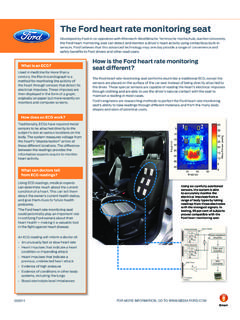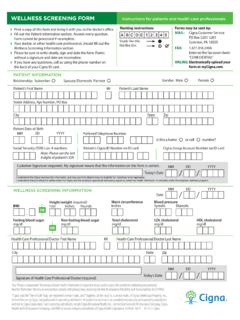Transcription of Cigna Medical Coverage Policy - medtees.com
1 Cigna Medical Coverage Policy Subject Electrophysiological 3-Dimensional Mapping Effective 10/15/2012 Next Review Date .. 10/15/2013 Coverage Policy 0074 Table of Contents Coverage 1 General 1 Coding/Billing 6 7 Policy 12 Hyperlink to Related Coverage Policies Maze ProcedureRobotic Assisted SurgeryTranscatheter Ablation of Arrhythmogenic Foci in the Pulmonary Veins for the Treatment of Atrial Fibrillation INSTRUCTIONS FOR USE The following Coverage Policy applies to health benefit plans administered by Cigna companies including plans formerly administered by Great-West Healthcare, which is now a part of Cigna . Coverage Policies are intended to provide guidance in interpreting certain standard Cigna benefit plans. Please note, the terms of a customer s particular benefit plan document [Group Service Agreement, Evidence of Coverage , Certificate of Coverage , Summary Plan Description (SPD) or similar plan document] may differ significantly from the standard benefit plans upon which these Coverage Policies are based.
2 For example, a customer s benefit plan document may contain a specific exclusion related to a topic addressed in a Coverage Policy . In the event of a conflict, a customer s benefit plan document always supercedes the information in the Coverage Policies. In the absence of a controlling federal or state Coverage mandate, benefits are ultimately determined by the terms of the applicable benefit plan document. Coverage determinations in each specific instance require consideration of 1) the terms of the applicable benefit plan document in effect on the date of service; 2) any applicable laws/regulations; 3) any relevant collateral source materials including Coverage Policies and; 4) the specific facts of the particular situation. Coverage Policies relate exclusively to the administration of health benefit plans. Coverage Policies are not recommendations for treatment and should never be used as treatment guidelines.
3 In certain markets, delegated vendor guidelines may be used to support Medical necessity and other Coverage determinations. Proprietary information of Cigna . Copyright 2012 Cigna Coverage Policy Cigna covers the use of an intracardiac electrophysiological 3-dimensional mapping system as medically necessary when used to guide radiofrequency ablation in the treatment of supraventricular arrhythmias. Cigna does not cover the use of an intracardiac electrophysiological 3-dimensional mapping system when utilized in the diagnosis, treatment, or management of ventricular arrhythmias because it is considered experimental, investigational or unproven. General Background The underlying cause of an arrhythmia provides the basis for selecting treatment. The least invasive treatment that controls the arrhythmia is the treatment of choice. The treatment options can include lifestyle changes, medications, devices, ablation procedures and surgery, including the implantation of pacemakers and defibrillators.
4 Cardiac ablation is typically used to treat rapid heartbeats that begin in the upper chambers, or atria, of the heart which are known as supraventricular tachycardias (SVTs). Types of SVTs are: atrial fibrillation (AF), atrial flutter, atrioventricular (AV) nodal reentrant tachycardia, AV reentrant tachycardia, and atrial tachycardia. Less frequently, ablation can treat heart rhythm disorders that begin in the heart s lower chambers, known as the ventricles. The most common, ventricular tachycardia, may also be the most dangerous type of arrhythmia Page 1 of 12 Coverage Policy Number: 0074 because it can cause sudden cardiac death. For many types of arrhythmias, catheter ablation is successful, therefore eliminating the need for open-heart surgeries or long-term drug therapies. The conventional two-dimensional cardiac mapping procedure used to guide radiofrequency catheter ablation for the treatment of cardiac arrhythmias uses a roving mapping catheter, a computerized mapping system, and fluoroscopy to determine the location of the mapping catheter.
5 In the conventional cardiac mapping procedure, both the patient and the electrophysiologist are exposed to potentially significant doses of ionizing radiation during the course of the lengthy procedure. The two-dimensional images produced by the fluoroscopy may not provide precise catheter location and do not allow for visualization of the endocardial surfaces. To improve the accuracy of cardiac mapping and reduce exposure to potentially dangerous ionizing radiation, three-dimensional (3-dimensional) magnetic navigation mapping systems have been developed. This has also been referred to as electroanatomic mapping. Three-dimensional magnetic navigation mapping systems ( , CARTO EP Navigation System; EnSite System) are used to guide radiofrequency catheter ablation for the treatment of cardiac arrhythmias. These non-fluoroscopic, catheter-based, electro-anatomic mapping systems locate the arrhythmia focus or foci which deliver radiofrequency (RF) energy via an intracardiac catheter which destroys the targeted myocardial tissue.
6 Three-dimensional mapping systems consist of a magnetic field generator locator pad which is placed under the patient s table or patches on the patient's skin track the catheter, a sensor-mounted catheter and a reference catheter placed intracardially, a mapping system, and a graphic computer. The mapping systems use algorithms to translate data on the catheter's location into a 3D image. A 3-dimensional map is generated, and sensor-mounted catheters are manipulated without fluoroscopy. Three-dimensional magnetic navigation mapping systems are sometimes called multi-modality mapping or image integration systems because they can show pictures or data from other sources. For instance, patient CT or MRI scans taken a few days or weeks before the procedure may be loaded onto the three-dimensional magnetic navigation mapping systems and matched with the real time 3D image of the heart.
7 It is now standard to integrate patient-specific preacquired 3-dimensional models of the left atrium and pulmonary veins (generated using either contrast-enhanced computed tomography or magnetic resonance imaging) with mapping systems to guide better the ablation procedure (Kistler, et al.; 2008; Reddy, 2008; Akhtar, 2004; Kumar, et al., 2002). Some of the procedure-reported complications during mapping procedures include catheter manipulation complications: perforation of the atrial appendage, heart or left atrium; and acute pericardial tamponade. Lower-extremity burns have been reported related to the reference patch interface and leg lead electrodes (Manufacturer and User Facility Device Experience Database [MAUDE], 2010). Cerebrovascular accident 24 hours after ablation, cardiac tamponade, complete AV block, severe pulmonary edema, and femoral arterial AV fistula requiring surgical repair have been reported in some the clinical studies (Verma, et al.)
8 , 2005; Nademanee, et al., 2004). Textbook literature on cardiac mapping states electrophysiological mapping systems been validated and used to facilitate mapping in patients with a variety of arrhythmias in all cardiac chambers. However, due to the sequential nature of map acquisition, use of this system is not recommended for patients with short-lived, polymorphic, or hemodynamic unstable arrhythmias, except for scar mapping and catheter navigation. The presence of extensive structural heart disease and multiple VTs contributes to difficulties in mapping and ablation of VT (Markides, et al., 2004). Robotic or remote catheter navigation has been proposed to improve navigation precision and to shorten cardiac ablation procedures. A robotic ablation starts the same way as a traditional catheter ablation. The doctor inserts a catheter into the groin and guides the catheter to the right side of the heart.
9 After making a puncture in the septum, the wall that separates the right and left sides of the heart, the doctor goes to the control system for the robotic system, which is usually located in an adjacent room. An example of robotic catheter system is the Niobe magnetic navigation system (Stereotaxis, Inc, St. Louis, MO) that only works with the CARTO electroanatomic mapping system (Biosense Webster, Inc., Diamond Bar, CA) and Biosense Webster mapping and ablation catheters. Another robotic navigation system is the Sensei X Robotic Catheter System (Hansel Medical , Mountain View, CA) that works with the EnSite System (St Jude Medical , St. Paul, MN). For information on the Coverage of robotic cardiac surgery, please refer to the Cigna Reimbursement Policy , Robotic Assisted Surgery (Akca, et al., 2012; ECRI, 2010). Food and Drug Administration (FDA) Page 2 of 12 Coverage Policy Number: 0074 The CARTO EP Navigation System (Biosense Webster, Inc.)
10 , Diamond Bar, CA) received 510(k) premarket approval in December 1999 by the Food and Drug Administration (FDA) as a Class II device for catheter-based cardiac mapping (FDA, 1999). The FDA indications for use state the intended use of the CARTO EP Navigation System is catheter-based cardiac mapping. The CARTO EP Navigation System and accessories have had numerous enhancements with the latest device, the CARTO 3 Version EP Navigation System and accessories, receiving 510(k) premarket approval in 2009 (FDA, 2009; FDA, 2006; FDA, 2000). The EnSite System (St Jude Medical , St. Paul, MN) received 510(k) premarket approval in 2003 as a Class II device for electrophysiology cardiac mapping (FDA, 2003). Literature Review Supraventricular Arrhythmias: Evidence in the published, peer-reviewed Medical literature supports the use of an intracardiac electrophysiological 3-dimensional mapping system to guide radiofrequency ablation for the treatment of supraventricular arrhythmias.







